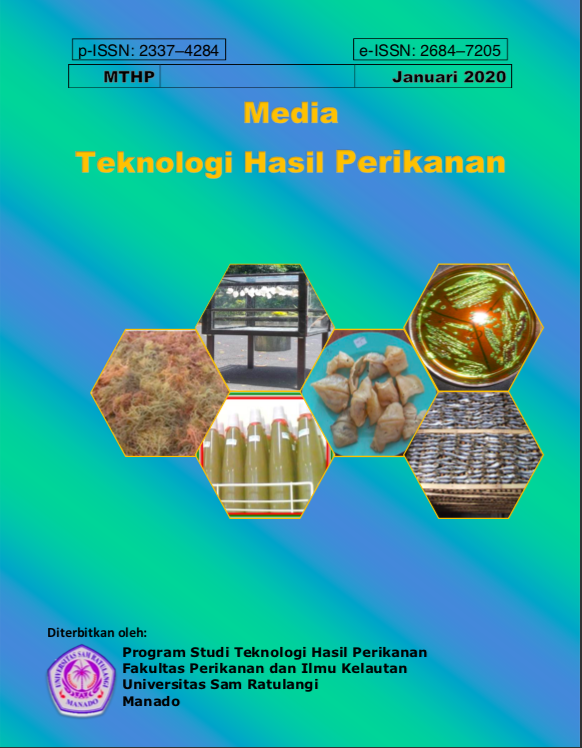Kualitas Organoleptik dan Isotermis Sorpsi Air (ISA) Ikan Cakalang (Katsuwonus pelamis L.) Presto Asap Cair
DOI:
https://doi.org/10.35800/mthp.8.1.2020.26012Keywords:
ikan cakalang, asap cair, presto dan isotermi sorpsi air (ISA), skipjack tuna, liquid smoke, presto and Moisture Sorption Isotherm (MSI)Abstract
Skipjack tuna is widely consumed by the people in North Sulawesi in many forms. One famous product is Cakalang Fufu or Smoked Skipjack. Conventional smoked skipjack fish processing has many shortcomings i.e.  longer processing time and the presence of tar residues and aromatic polycyclic hydrocarbon compounds (benzo(a)pyrene) which are harmful to human health. The use of liquid smoke is safer since the concentration of liquid smoke can be controlled. Additionally,  it is equipped with a cooking method to produce fish with soft fins and bones so that it can be directly consumed. The purpose of this study was to obtain the best formula in the process of making liquid smoked skipjack. Two concentrations of liquid smoke 0.8% and 1.2, three various cooking time using pressure cooker presto (60, 90 and 120 minutes), and  two ways of administering liquid smoke were used as treatments. Sensory hedonic test, duo-trio test, MSI test, moisture content, pH and phenol value were measured in this study.The results showed that  the best formula in this study was to soaked skipjack tuna in 1.2% liquid smoke, cooked with pressure cooker for 90 minutes and then heated at a temperature of 150°C for 30 minutes.  The Duo Trio Test results showed that skipjack tuna in 0,8% and 1.2% liquid smoke concentration either by soaked the fish in advance and cooked by pressure cooker, or cooked by pressure cooker in liquid smoke were tastier than conventional smoked fish samples.Moisture Sorption Isotherm (MSI) test results show that all skipjack tuna with liquid smoke, at RH> 60% will begin to absorb the water, so packaging is needed in this part. The MSI Oswin curve model accurately describes the actual curve with an MRD value of 7.51
Downloads
Published
How to Cite
Issue
Section
License
Authors who publish with this journal agree to the following terms:
- Authors retain copyright and grant the journal right of first publication with the work simultaneously licensed under a Creative Commons Attribution License that allows others to share the work with an acknowledgement of the work's authorship and initial publication in this journal.
- Authors are able to enter into separate, additional contractual arrangements for the non-exclusive distribution of the journal's published version of the work (e.g., post it to an institutional repository or publish it in a book), with an acknowledgement of its initial publication in this journal.
- Authors are permitted and encouraged to post their work online (e.g., in institutional repositories or on their website) prior to and during the submission process, as it can lead to productive exchanges, as well as earlier and greater citation of published work (See The Effect of Open Access).






